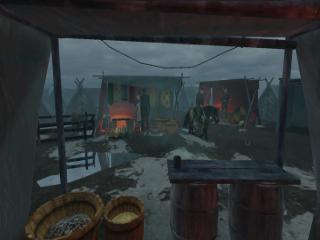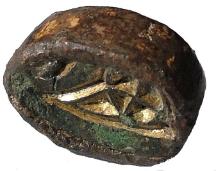Tents to Towns: the Viking Great Army and its Legacy
Overview
Our 2011-18 research project on Viking Torksey has now been extended to understand the wider context of the Viking Great Army.

From AD 865 to 879 the so-called Viking Great Army wreaked havoc on the Anglo-Saxon kingdoms, leading to political conquest, settlement on a substantial scale, and extensive Scandinavian cultural and linguistic influences in eastern and northern England. Yet despite the pivotal role of the Great Army in these events, little is known of it; the available documentary sources provide few insights into its activities and intentions, and until now archaeological evidence has largely remained elusive. For many years excavations at Repton provided the type site, of a small D-shaped enclosure, but this interpretation can now be seen to be flawed and newly discovered winter camps at Torksey and Aldwark tell a different story.
Our archaeological evaluation of the site where the Great Army over-wintered in AD 872-3 at Torksey, in Lincolnshire, has demonstrated that further research here has the potential to tell us a huge amount about this critical period, including the composition of the army, what it was doing, and what its legacy was. Based upon our evaluation, ‘Tents to Towns’ is a five-year project which addresses a broad range of inter-disciplinary research to allow us to place Torksey in context. We have four interrelated research questions:
- What was the scale and location of the winter camps, why were they placed in these locations, and what communication networks were used by the Great Army to allow it to move so rapidly across Anglo-Saxon England?
- Who occupied the camps and what types of activities took place there?
- Using the ‘archaeological signature’ of the Great Army we have already identified at Torksey, where else in England do we find traces of it?
- What was the impact of the Viking Great Army on the development of towns, trade and industry, particularly on it spottery industry?
Funding has been provided by the British Academy and the Society of Antiquaries of London.
Methods
The research is proceeding through 9 interrelated work packages:
1) Analysis of the PAS database and Historic Environment Records
We will continue our work integrating metal-detected finds recorded on the PAS database with the evidence from published archaeological studies and the ‘grey literature’ reports deriving from developer-funded investigations.
2) Landscape based study of locations and transport routes
The locations of sites with a Great Army signature will be assessed by desk-based study and site visits pursuing our preliminary discovery that they are often located close to river crossings and Roman roads.
3) Study of written sources
To contextualize the locations of the winter camps and other sites revealing the presence of the Great Army, both contemporary and later written sources will be examined.
4) Fieldwork
We will undertake excavations in Torksey, focussing on the winter camp and Anglo-Saxon town.
5) Torksey assemblage analysis and database enhancement
We will undertake detailed analysis of over 2000 finds, enhancing the database, and increasing our understanding of the range of activities and people on the camp.
6) Torksey metalwork compositional analysis
Evidence for metalworking will be investigated by typological study and compositional analysis using pXRF and SEM.
7) Pottery analysis
We will explore the emergence and development of pottery industries in the three main regions where the Great Army was active: East Anglia, the East Midlands and Northumbria.
8) Analysis of grey literature
Using published reports and grey literature held by ADS and HERs we will analyse the specific contribution of the Great Army to urban development and industry.
9) Skeletal assessment and stable isotopes analysis
Fieldwalking in the Castle Field has retrieved human remains, within an enclosure, radiocarbon dated to the 10th century, and these will be analysed and compared with those from four other 10th-century cemeteries in Torksey, and two groups of burials from the winter camp.
People
University of York
Principal Investigators
Collaborators
- Steve Ashby
- Gareth Perry; pottery specialist
University of Sheffield
- Elizabeth Craig-Atkins; human osteology
External Collaborators
- Adam Daubney, PAS Finds Liaison Officer, Lincoln
- Dave Haldenby, Independent; strap end specialist
- Mark Hall, Perth Museum; gaming expert
- Ailsa Mainman; pottery specialist
- Patrick Ottaway, Independent; Viking ironwork specialist
- Unn Pedersen, University of Oslo, Viking weights
- Andrew Woods, York Museums Trust; numismatist
Publications
Journal articles
Hadley, D.M., Richards, J.D., Perry, G. and Craig-Atkins, A. 2022 'From tents to towns: tracing Torksey after the Vikings', Current Archaeology 385
Hadley, D.M. and Richards, J.D. 2018 "In Search of the Viking Great Army: Beyond the Winter Camps", Medieval Settlement Research 33
Hadley, D.M. and Richards, J.D. forthcoming "Changing Places: Tracing the Viking Great Army in the Anglo-Saxon countryside", Proceedings of the 18th Viking Congress
Richards, J.D. and Haldenby, D. 2018 "The scale and impact of Viking settlement in Northumbria", Medieval Archaeology 62
Monographs
Hadley, D.M. and Richards, J.D. 2021 The Viking Great Army and the Making of a Nation. Thames & Hudson
Hadley, D.M. and Richards, J.D in prep Tents to Towns: the Viking Great Army and its Legacy. Oxford University Press
Popular Reports
"The Great Viking Terror", by Julian Richards and Dawn Hadley, BBC History Magazine (Sept 2016), 36-41
Presentations
East Riding Archaeological Society, 20 February 2019
- J.D.Richards: "Beyond the winter camps: new evidence for the Viking Great Army in the East Riding"
Settlement in the Danelaw. Medieval Settlement Research Group, 8 December 2018
- D.M.Hadley: "The Viking Great Army: beyond the winter camps"
- J.D.Richards: "The Viking Great Army: raiding and settlement in Northumbria"
Malton Museum Summer lecture, 22 Sept 2018
- J.D.Richards: "The Impact of the Viking Great Army"
European Archaeological Association, Barcelona, 5-8 Sept 2018
- D.M.Hadley, J.D.Richards, D.Murphy, G.Beale, N.Beale, G.Schofield, J.Hook: "Viking Virtual Reality: Inside the Great Army's winter camp"
Viking Winter Camps - organisation and movement seminar, Santiago de Compostela, 1-4 September 2018
- D.M.Hadley: "The winter camp of the Viking Great Army at Torksey: an update"
- J.D.Richards: "The Viking Great Amry in England: Beyond the winter camps"
Grimsby and District Metal-detecting Club, 14 August 2018
- J.D.Richards: "In the footsteps of the Viking Great Army: From Torksey to Swinhope and Binbrook"
Virtual reality
We are continuing to use innovative digital methods to disseminate our results:
‘Viking VR: Designing a Virtual Reality Experience for a Museum’, Association for Computing Machinery Conference on Designing Interactive Systems (2018) (G. Schofield, G. Beale, N. Beale, M. Fell, D. Hadley, J. Hook, D. Murphy, J. Richards, L. Thresh)
Contact details
Contact details

